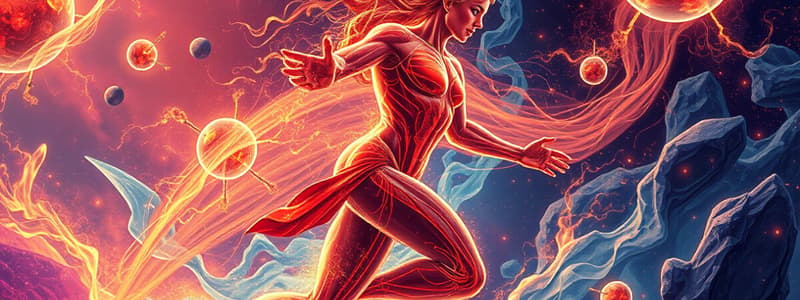Podcast
Questions and Answers
Where does most aerobic and anaerobic energy metabolism occur?
Where does most aerobic and anaerobic energy metabolism occur?
Aerobic metabolism occurs inside the mitochondria; anaerobic metabolism occurs in the cytoplasm.
What is glycolysis and where does it occur?
What is glycolysis and where does it occur?
Glycolysis is the first step in carbohydrate metabolism, occurring in the cytoplasm.
How are fats metabolized for energy?
How are fats metabolized for energy?
Fats are broken down into fatty acids and glycerol; fatty acids undergo beta oxidation.
What happens to proteins during times of starvation?
What happens to proteins during times of starvation?
What is the final step in energy metabolism?
What is the final step in energy metabolism?
How is glycolysis related to energy metabolism?
How is glycolysis related to energy metabolism?
What happens to excess glucose after energy needs are met?
What happens to excess glucose after energy needs are met?
What compounds may be stored as fat?
What compounds may be stored as fat?
Define catabolism.
Define catabolism.
Define anabolism.
Define anabolism.
Define anaerobic metabolism.
Define anaerobic metabolism.
Define aerobic metabolism.
Define aerobic metabolism.
Define urea.
Define urea.
Define lipogenesis.
Define lipogenesis.
Flashcards are hidden until you start studying
Study Notes
Energy Metabolism Overview
- Aerobic metabolism occurs inside the mitochondria; anaerobic metabolism occurs in the cytoplasm.
Glycolysis and Carbohydrate Metabolism
- Glycolysis is the initial step in carbohydrate metabolism, converting glucose to pyruvate; it operates anaerobically in the cytoplasm.
- If oxygen is present, pyruvate enters the mitochondria for aerobic metabolism, producing acetyl CoA, which feeds into the TCA cycle (Kreb's cycle) for significant ATP production.
- In the absence of oxygen, pyruvate is converted to lactate, yielding a small amount of ATP.
Fat Metabolism
- Fats are stored as triglycerides; during energy use, they are broken down into fatty acids and glycerol.
- Glycerol can transform into glucose or pyruvate, while fatty acids undergo beta-oxidation to yield acetyl CoA.
- Acetyl CoA combines with oxaloacetate to enter the Kreb's cycle. Low carbohydrate intake can cause ketone build-up, risking ketosis and ketoacidosis.
Amino Acid Metabolism
- Proteins can serve as an energy source during starvation or limited carbohydrates.
- Deamination removes the nitrogen group from amino acids, converting it to urea for excretion.
- The remaining carbon skeletons can enter the Kreb's cycle as pyruvate or acetyl CoA.
Final Steps in Energy Production
- Electrons from the Kreb's cycle are shuttled by NAD and FAD to the Electron Transport Chain (ETC), producing ATP.
- Oxygen is crucial in aerobic metabolism, acting as the final electron acceptor, while water and CO2 are byproducts.
Glycogen Storage and Energy Use
- Excess glucose is stored as glycogen; liver glycogen maintains blood glucose levels, while muscle glycogen provides energy for muscular activity.
- Glycogen stores are limited and deplete quickly; any surplus glucose is converted to fat.
Macronutrient Metabolism and Storage
- Fats, carbohydrates, alcohol, and amino acids can be converted and stored as fat when energy needs are satisfied.
Metabolic Processes
- Catabolism defines the breakdown of molecules for energy production.
- Anabolism describes the process of building larger molecules from smaller units.
Metabolic Definitions
- Anaerobic metabolism operates without oxygen and produces lesser ATP.
- Aerobic metabolism requires oxygen and generates substantial ATP.
- Urea is a key nitrogenous waste product formed from protein metabolism, excreted in urine.
- Lipogenesis is the process by which substances converting into acetyl CoA can be synthesized into fat.
Studying That Suits You
Use AI to generate personalized quizzes and flashcards to suit your learning preferences.




